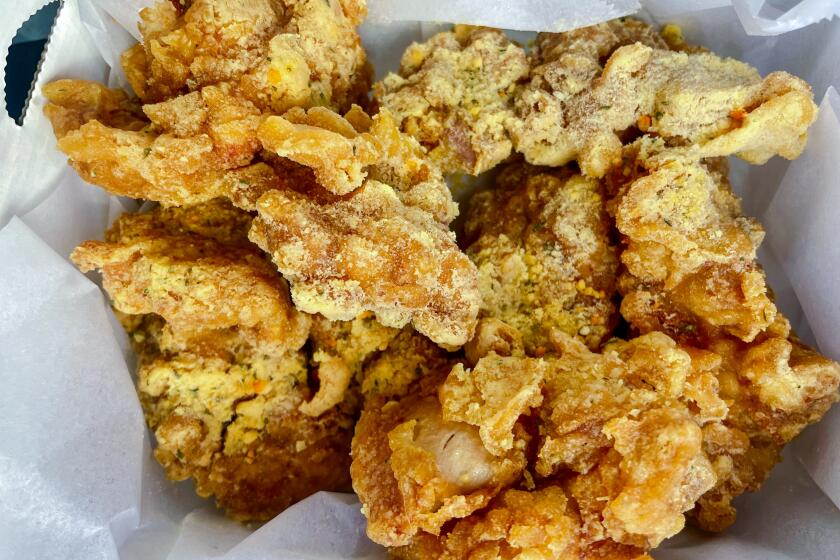Cookbook Watch: ‘Japanese Farm Food’
Holiday traffic, gift shopping, partying…. It’s a relief to slow down with a good cookbook that reflects an idyllic life on a farm in northern Japan, where the cooking revolves around food that’s grown at home and prepared simply. “Japanese Farm Food” by Nancy Singleton Hachishu, who moved from California to Japan and ended up marrying a farmer and living in his ancestral home two hours from Tokyo, is a transporting respite.
The book opens with a description of her Japanese farmhouse kitchen, a place of wood posts and beams, filled with her collection of 100-year-old baskets and bowls. In her pantry: soy sauce, sea salt, katsuobushi (dried, smoked bonito), konbu (dried kelp), rice vinegar, sake, mirin and miso are the basics she encourages readers to use. (A full glossary describes more-unusual ingredients: roasted soy bean powder, soy milk skin, Japanese dried chiles, agar, etc.)
Though she makes her own tofu and plucks ducks at Christmastime, most of the recipes in the nearly-400-page book are approachable. It’s “bold, clear, direct” food, she writes. She cooks and eats what the farm yields, as well as meat from the local butcher and fish from the fish market.
Snacks to go with drinks include treviso and sansho leaves served with miso mixed with pecans (hers are homegrown), or hard-boiled eggs marinated in soy sauce. Simple pickles include turnips and their leaves mixed with sea salt, Meyer lemon and chile.
Living on a farm, “you don’t choose the vegetables, they choose you.” Hachisu incorporates asparagus into small pots of savory egg custard, or pours the custard into emptied sour orange halves with flowering mustard. Cauliflower gets tossed with miso and sesame, broccoli with tofu and yuzu, and salt-rubbed eggplant with ginger and shiso. Bittermelon is stir-fried with egg and chiles.
“Touching vegetables while they are living is something every cook should do. You have to accept them, not force your will on them.”
My favorite chapter might be the one on noodles and rice, which includes recipes for simmered gyoza (pork-filled dumplings), homemade ramen, udon noodles, soba with walnut dipping sauce, somen with ginger and scallions, salty salmon rice balls and miso-grilled rice balls, yellowtail sashimi on hot rice with broth,
Throughout the book are notes on technique (washing rice and cutting sashimi, for example), on ingredients (natto, or fermented soy beans) and on farm life (edamame season).
I’m already thinking about summer when I can make umeshu, the cordial traditionally made with sour plums. Soak a couple of pounds of apricots along with sugar in a neutral spirit for three months in a cool, dark place -- next winter around this time I’ll be sipping on the umeshu. And still daydreaming about a farm in Japan.
“Japanese Farm Food” by Nancy Singleton Hachisu; Andrew McMeel. $40.
Salt-massaged cucumber with miso and sesame
1 3/4 pounds Japanese cucumbers (7 or 8 small)
1/2 tablespoon fine sea salt
4 tablespoons unhulled sesame seeds
3 tablespoons brown rice miso
2 tablespoons rice vinegar
6 shiso leaves
1. Slice the cucumbers into paper-thin rounds and toss with the salt in a medium-sized bowl. Let sit 10 minutes.
2. Toast the sesame seeds over medium-high heat in a dry frying pan until they are fragrant and start to pop. Grind the sesame seeds with a suribachi (Japanese grinding bowl) or mortar until most of the seeds have broken down and are almost pastelike. Add the miso and rice vinegar and blend until creamy.
3. Squeeze the cucumbers by handfuls to express the water, then add the cucumbers to the sesame-miso mixture.
4. Stack the shiso leaves, roll into a cigar shape, and slice into fine tendrils; toss gently but well with the cucumbers.
Apricot cordial
2 pounds apricots
1 pound organic sugar or white rock sugar
2 quarts white liquor (or plain vodka)
1. Wipe the apricots and place them in a large clean jar or sealable crock. Add the sugar and liquor, and cap securely. Shake to distribute and help dissolve the sugar.
2. Let the fruit and liquor macerate for at least 3 months in a cool, dark place. Shake occasionally. Taste after 3 months, and if the liquor is sufficiently infused with apricot, it is ready to serve. This cordial keeps practically indefinitely, though the taste will intensify over time.
3. Serve cold over ice as a before-dinner drink.
ALSO:
Christmas 2012 L.A. dining guide
Holiday cookie recipe: Amanda’s amazing sugar cookies
More to Read
Eat your way across L.A.
Get our weekly Tasting Notes newsletter for reviews, news and more.
You may occasionally receive promotional content from the Los Angeles Times.











